Go
back to Behaviorism Articles & Chapters
The
Three-Contingency Model of Performance Management Applied to Welfare
Reform
Richard W. Malott1
Behavior Analysis Program
Department of Psychology
Western Michigan University
Download
Word version of this article
Abstract
Rosie O’Grady and the colonel’s lady are sisters
under the skin.—Rudyard Kipling
The three-contingency model of performance management suggests contingencies
that could provide an effective basis for welfare reform. This model
also suggests an analysis of the performance-management contingencies
of traditional efforts at welfare reform; and, in turn, that analysis
suggests such traditional reform will not effectively increase functional
behavior such as job finding nor decrease dysfunctional behavior such
as drug abuse. This article is inspired by Nevin’s (1999) analysis
of welfare reform.
THE STORY
Dora’s
Deal
Dora sat fidgeting in the drab office of her case worker, Debby,
looking at the floor as Debby continued, “Now, Dora, let us
make absolutely sure you understand this; your support checks, your
food stamps, and your medical insurance will last just two years from
today. After that, no more money, no more food stamps, and no more
medical insurance. So you’ve got to get hustling, right now;
it’s no easy thing to find a job. I know two years seems like
a long time, but that time will fly. Now are you sure you understand
this?”
“Yes, ma’am, I sure do understand. But don’t you
worry none about me waitin’ no two years to find a job. I wants
a job right now. This welfare business humiliate a woman; and ever’
time I see her, my mama axe me when I gonna’ get a job. Besides,
a body can’t feed and clothe three children on what welfare
pay. I’m gonna’ start my job search first thing tomorrow”
Dora replied with grim determination.
“By the way,” Debby said, “I see you have two prior
arrests for possession of an illegal substance. You know, if you get
convicted of a drug felony while you’re receiving welfare support,
you will lose that support immediately.”
“Ma’am, don’t you worry ‘bout me none; I am
clean now.”
Debby’s
Deal
Debby sat fidgeting in the drab office of her doctoral committee
chair, Dirk , looking at the floor as Dirk continued, “Now Debby,
let us make absolutely sure you understand this; you’ve got
just two more years to finish your dissertation. Then you’ve
hit the graduate school limit, and Big State U. will drop you from
the program. So you’ve got to get hustling, right now; it’s
no easy thing to do a Ph.D. dissertation. I know two years seems like
a long time, but that time will fly. Now, are you with me?”
“Yes, Dr. Duke, I sure am. But you don’t have to worry
about me; you know I’m a self-starter. Getting my Ph.D. means
a promotion and a pay raise. And still being in school is humiliating
for a woman my age; every time I see her, my mother asks me when I’m
going to graduate. Besides, I want to send my daughter to a private
school, and I can’t do that on what Social Services pays a caseworker.
I’m going to start my literature search the first thing tomorrow,”
Debby replied, with grim determination.
Dora’s
Day
Dora’s oldest daughter grabbed the last Dunkin’ D. donut
from the box on the card table and headed off to school. Dora thought,
“Now, I’ll pick up a newspaper and checkout the classifieds,”
as she flipped on CNN. “Oh, my lord, the President did that,
and on an Easter Sunday,” she said and sat down in front of
the TV. “I’ll just watch for a couple minutes, before
I go to the newsstand.”
Two hours later, Dora arrived at the newsstand; but before she started
browsing through the boring classifieds, she’d just glance at
People Magazine. An hour later, she recalled that her two younger
children were alone, so she dropped People M. and rushed home.
Debby’s
Day
Debby’s daughter finished her granola and skimmed milk, rinsed
off the dish and spoon, and headed off to school. Debby thought, “Now,
I’ll pick up Psych. Abstracts and checkout the references,”
as she flipped on NPR. “Oh, god, the President did that and
on an Easter Sunday,” she said and sat down in front of the
FM. “I’ll just listen to NPR for a couple minutes, before
I go to the library.”
Two hours later, Debby arrived at the library, but before she started
browsing through the boring Psych. Abstracts, she’d just glance
at the APA Monitor. An hour later, she realized she’d soon be
helping support BSU’s scholarship fund, so she dropped the APA
M. and rushed out to her car, just before the officer had a chance
to ticket it. Not enough time to go back to the library now; it was
almost time for lunch and then the P.M. shift at the office.
Dora’s
Month
Dora sat fidgeting in the drab office of her case worker, looking
at the floor as Debby continued, “So, Dora, how’s the
job search going? Any hot leads? Any interviews?”
“Well, ma’am, I ain’t exactly had no interviews
yet; but I be workin’ on it,” Dora replied. “It’s
jess that it’s so hard, what with the babies and all; you know
I can’t afford no baby sitter.”
“That’s a good point,” Debby said. “And Social
Services now has a new support system where you can take your children
to our child-care facility while you look for a job.”
“Oh, that be jess the ticket, ma’am. That’ll really
help,” Dora said.
Debby’s
Month
Debby sat fidgeting in the drab office of her doctoral committee
chair, looking at the floor as Dirk continued, “So, Debby, how’s
the lit review going? Any hot leads? Any dissertation ideas?”
“Well, Dr. Duke, I don’t have any viable ideas yet; but
I’m getting close,” Debby replied. “It’s just
that it’s so hard not having my own computer to do lit searches
on the Internet so I can download the results into a data base. And
I can’t afford a computer.”
“That’s a good point,” Dirk said. “And BSU’s
Grad. College now has a new program where they will give students
interest free loans to buy computers for working on their dissertations,
especially for nontraditional students.”
“Oh, that’s wonderful, Dr. Duke. That will really help,”
Debby said.
Dora’s
Year
Dora fidgeted, as Debby continued, “Dora, it’s been a
year; and you haven’t shown any sign of progress toward getting
a job.”
Dora: “Well, it’s hard to know where to start. I . . .”
Debby: “Did you even called a single employer all year?”
Dora: “Well, ah . . .”
Debby: “I’m going to enroll you in my weekly confidence-building
support group. You’re going to learn to be assertive and cope
with your fear of failure; and we’ll also discuss how you’re
feeling about yourself.”
“Oh, that’s just the ticket, ma’am. That’ll
really help,” Dora said.
Debby’s
Year
Debby fidgeted, as Dirk continued, “Debby, it’s been
a year; and you haven’t even turned in your dissertation proposal,
let alone collected any data.”
Debby: “Well, I’ve spent a lot of time on the web looking
for . . .”
Dirk: “I haven’t even seen an outline of your proposal.”
Debby: “Well, it’s so hard with my full-time job and my
daughter; and I am a single parent; I . . .”
Dirk: “I want you to attend the Grad. College’s weekly
dissertation support group, where you’ll learn to write using
the APA Style guidelines, to design good research, and how to search
the web for research references.”
“Oh, thank God; that’s just what I need, Dr. Duke. That
will really help,” Debby said.
Dora’s
Doom
Debby: “Dora, you got arrested for possession of a controlled
substance and it looks like you’ll get convicted. And your two
years are up but still no job. I hate to say this, but you’ve
really disappointed me; and worse than that, you’re now going
to lose all social service support. I’m really sorry Dora, but
you’ve brought it all on yourself. I don’t know what’s
the problem with you people.”
Dora: “You right, ma’am. I’d don’t know what’s
wrong with me either.” Dora wiped her eyes with the back of
her hand. “I don’t know what’s gonna’ become
of me; and what they gonna’ do with my babies?”
Actually, Debby did know what was the problem with those people: “These
welfare mothers have absolutely no will power, don’t appreciation
the value of a job, can’t find their butts with a road map,
have no sense of responsibility, and no ability to delay their gratification.
What’s worse, it’s genetic; the only solution is eugenics.”
Debby’s
Doom
Dirk: “Debby, your two years are up; and not only did you not
finish your dissertation, you never even wrote a proposal. I hate
to say this, but you’ve really disappointed me; and worse than
that, you will be dismissed from our graduate program. I’m really
sorry Debby, but you’ve brought it all on yourself. I don’t
know what’s the problem with graduate students today.”
Debby: “You’re right, Dr. Duke. I don’t know what’s
wrong with me either.” Debby wiped her eyes with a tissue from
her purse. “I’ve spent so much time and money on my Ph.D.
degree; now it’s all lost, and I have to make payments on that
computer for the next four years.”
Dr.
Dirk Duke’s Doom
Dirk walked down to the faculty mailroom thinking with disgust about
Debby, “The field’s better off without a weak sister like
her who can’t find their butt with a road map. Grad students
today are just in it for a free ride. They have no sense of responsibility.
Their priorities just aren’t academic; they’re priorities
are in terms of having a good time. They aren’t real scholars;
they don’t really value a Ph.D. degree. And they can’t
delay their own personal gratification long enough to do what a scholar
needs to do. They aren’t like we were six years ago, when I
was a grad student.”
Then Dirk pulled the letter out of his mail box, opened it. It was
from Dean Bean: “Dear Dr. Dirk: I regret to inform you that
you have been denied tenure, because, during the past six years, you
failed to demonstrate sufficient scholarly productivity in terms of
the number of articles published in referred journals and in terms
of effort to achieve external funding for your research.”
What Dean Bean thought, but did not write was: “Big State U.
is better off without weaklings like this Duke character who can’t
find his butt with a road map. No sense of responsibility. Their priorities
just aren’t academic; not real scholars. Can’t delay their
personal gratification long enough to sit down and write an occasional
article. They aren’t like we were 18 years ago, when I was an
assistant professor.”
Debby’s
Deliverance
Debby sat fidgeting in the drab office of Dr. Bobby Behavior, looking
at the floor as Bobby continued, “Now here’s the deal:
I’ve talked the Department and the College into letting you
stay in our grad program, as long as you’re meeting the weekly
subgoals specified by a performance-management contract and are making
good progress on your dissertation. In addition, I’m willing
to take over Dr. Duke’s vacated position as chair of your committee,
if you’d like.”
“Oh, Dr. Behavior, I sure would appreciate that,” Debby
said.
“That’s good,” Bobby thought, “because no
one else was willing to chair your committee; but then no one else
really thinks behavior management should be applied to anyone but
the mentally handicapped and factory workers.” But what Bobby
B. said was, “We’ll break the long-range goal of completing
your dissertation into weekly subgoals. Then we’ll break the
weekly subgoals into daily subgoals. And you can e-mail me your accomplishments
once a day. Then we’ll meet once a week to review your proofs
of accomplishment and fine tune your performance-management contract
for the next week.”
“But, Dr. Behavior, I can’t even figure out a topic for
my dissertation,” Debby said.
“How about going for a two fer; how about doing your dissertation
where you work, at social services, like find some serious behavioral
problem there and use behavior analysis to solve it?” Bobby
B. said.
Dora’s
Deliverance
Debby: “Now here’s the deal: I’ve talked the Department
of Social Services into letting you continue with welfare support,
as long as you’re meeting the weekly subgoals specified by your
performance-management contract and are making good progress toward
finding a job.”
Dora: “Oh, Miz Debby, honey, I surely would appreciate that.”
Debby: “We’ll break the long-range goal of finding a job
into weekly subgoals. Then we’ll break the weekly subgoals into
daily subgoals. And you can call me about your accomplishments once
a day. And we’ll meet once a week to review your proofs of accomplishment
and fine tune your performance-management contract for the next week.”
THE
PROBLEM: NATURAL CONTINGENCIES
Traditional
Mentalistic Analyses
Why do Dora and Debby have trouble doing what it takes to find a
job or finish a dissertation? A traditional mentalistic analysis answers
this question in terms of invented inner causes, such as lack of will
power and lack of the ability to delay gratification (e.g., Dora and
Debby do not have the will power to resist the temptation of the immediate
gratification coming from People Magazine and the APA Monitor.). And
because it is hard to imagine why someone will not do something they
want to do, traditional analyses often infer a lack of appreciation
(e.g., lack of appreciation of the value of a job or a Ph.D. degree).
Many traditional explanations in terms of invented inner causes are
reifications, in that an activity (e.g., working toward a goal) is
transformed into a causal noun/thing (e.g., will power). And these
explanations are circular reifications to the extent that the proof
of the existence of that reified cause is inferred from the activity
it was invented to explain (e.g., they do not work toward their goal
because they lack will power, and you know they lack will power because
they do not work toward their goal) . (Malott, Whaley, & Malott,
p 29-30, 1997).
And why does Dora use illegal drugs? Again, a traditional mentalistic
analysis would answer in terms of circular reifications like lack
of will power and an inability to delay gratification; and if that
does not suffice an addictive personality can be reified into existence
and thrown in the pot of reification stew.
Traditional
Behavioristic Analyses
The Myth of
Incompatible Contingencies: Important Delayed vs. Trivial Immediate
Outcomes
Why do Dora and Debby have trouble doing what it takes to find a job
or finish a dissertation? A traditional behavioristic analysis answers
this question in terms similar to the mentalistic analysis, but the
“inability to delay gratification” is translated into
a “strong preference for immediate reinforcers rather than delayed
reinforcers” (e.g., the reinforcers of finding a job or getting
a Ph.D. degree are too delayed to compete with the immediate reinforcers
of scandal in the White House).
The same analysis applies to Debby’s procrastination.
And why does Dora do drugs? Again, a traditional behavioristic analysis
would answer in terms of strong control by the immediate reinforcing
effects of the drug vs. the weak control of the delayed harmful effects
of the drug.
In other words, the traditional behaviorist say this is a problem
of immediate vs. delayed outcomes. Such analyses are fortified by
extrapolations from the Skinner box where, indeed, behavior is more
readily controlled by immediate, contingent reinforcers than by 20-second-delayed
contingent reinforcers. But I will argue that such extrapolations
are overly simplified (Malott & Garcia,1991). In summary, these
traditional behavior analyses are essentially intellectualized versions
of grandmother’s common-sense analyses--"This new, me generation
just can't delay gratification like we could in the old days."
The Myth of
Incompatible Contingencies: Two Important Immediate Contingencies
A traditional behavior analysis will also point to other types of
competing contingencies. For example, traditionalists will point to
the contingencies with immediate outcomes controlling child care vs.
the contingencies with outcomes, either immediate or delayed failing,
to control the job search. (In the present example, the child-care
contingency is described in terms of a penalty contingency for searching
for job ads; this allows us to concentrate on the behavior of primary
interest, searching for job ads. The two previous pairs of diagrams
could also have been described in terms of penalizing the productive
behavior with the loss of the reinforcing opportunity to be scandalized.)
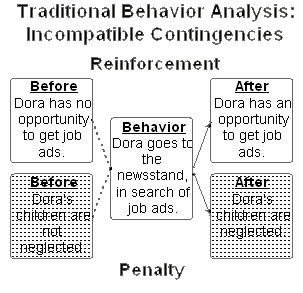
However, in these cases, the traditionalist implication is not so
much that the problem is due to the of lack of control by delayed
outcomes as much as that it is impossible to do two important, physically
incompatible things at once (e.g., search for job ads and take care
of children).
And these traditionalists will also point to the immediately aversive
punishment contingencies suppressing a computerless reference search.
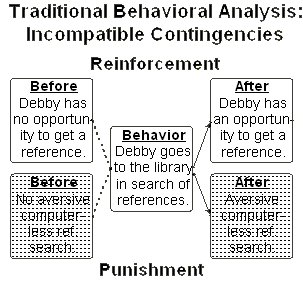
I will argue that even when you remove competing contingencies, the
ineffective natural contingencies and the ineffective performance
management contingencies, will still fail to control behavior.
Ineffective
Traditional Interventions: Eliminating Competing Natural Contingencies
It is a common but erroneous analysis to blame competing natural contingencies
for failure of other natural contingencies to control the behavior
as we wish. True, child-care contingencies do compete with job search
contingencies. But usually when such competing contingencies are eliminated
or greatly attenuated, the natural contingencies will still fail to
maintain job-search behavior at an adequate frequency. Although there
may be an increase in the frequency of going to the newsstand to check
out the job ads, for instance, that frequency will still be too low
to produce reliable success at job finding.
And true, the aversive effort contingencies associated with going
to the library to search for references do compete with reference-search
reinforcement contingencies. But, when the purchase of the computer
eliminates or greatly attenuates such punishment contingencies, the
natural contingencies will still fail to reinforce enough reference-search
and proposal-writing behavior. The frequency of Debby’s reference
searches will still be too low to produce reliable success at completing
her dissertation. Similarly, getting rid of the TV or the FM may help,
but it will not suffice.
Ineffective
Traditional Interventions: Removing Skill Deficits
It is also true that we need skills to accomplish tasks, and sometimes
we do not have those skills. But more often, people think the problem
is skill deficit when it is really failure of natural contingencies
to support task accomplishment. Therefore, often after skill training,
the frequency of task completion does not increase greatly. And therefore,
teaching Dora how to be properly assertive may have insufficient impact
on her job-search behavior. And while this may not fit too comfortably
in the skill-deficit area, workshops to increase Dora’s self-confidence,
even if the workshops are successful, will probably have little effect
on job searching. (In fact, informal observation suggests that often
it is those who fail to achieve who are the most confident that they
can procrastinate until the last minute and will still have plenty
of time to complete the task before the deadline; and they have this
false confidence, in spite of repeated failures to start working in
time to complete tasks by their deadlines. Only those plagued with
neurotic, unrealistic fears of failure to complete the task on time,
actually start work on the task early enough to actually complete
it on time.)
Similarly, Debby’s learning to write using the APA Style guidelines,
to design good research, and to search the web for research references
does not address the problem of the natural contingencies that are
ineffective in reinforcing her working on her dissertation.
A
Radical-behavioral Analysis
The Mythical Cause of Poor Self-management
It is correct that the delay between the response and the delivery
of the reinforcer is crucial for direct-acting behavioral contingencies
such as those studied in the Skinner box. However, the problematic
contingencies of primary concern in the lives of verbal human beings
usually involve outcomes that are so delayed they are only indirect-acting
analogs to the Skinner-box contingencies; the delays are so great
that the contingencies would not control behavior even indirectly
if the person could not state a rule describing those contingencies,
that is, if the behavior were not rule-governed (Malott, Whaley, &
Malott, p 332-380, 1997). But contrary to traditional mentalistic
and behavioristic analyses, the delay is not a problem, if the person
can state a rule describing the contingency (e.g., Dora has no trouble
saving the on-sale newspaper coupons from the local supermarket, even
though she will not be able to use them until she goes to the store
two days later; and Debby will have no trouble (well, not too much
trouble) preparing and sending her dissertation-poster proposal to
the Association for Behavior Analysis, even though she will not be
able to present her poster at the conference until seven months later.)
In summary, the traditional mentalistic and traditional behavioristic
analyses illustrate the mythical cause of poor self-management--poor
self-management results from control by immediate outcomes and the
lack of control by delayed outcomes; so we fail to act in our long-run
best interests.
As the sale coupons and the poster proposal suggest, contingencies
with delayed outcomes can control the behavior of verbal people, if
the people know the rules describing those contingencies. Then why
does Dora have so much trouble getting herself to search for a job?
And why does Debby have so much trouble getting herself to search
for dissertation references and dissertation topics and so much trouble
getting herself to write her dissertation proposal? If it is not the
delayed outcomes, what is it?
The
Real Cause of Poor Self-management
Effective Natural
Contingencies.
Let us look more closely at a term we have already been using, natural
contingencies. Natural contingencies are those contingencies that
occur in nature, without special intervention, those that are not
specifically designed to control behavior. Most natural contingencies
are effective and, therefore, attract little attention. Our lives
are full of effective, natural, direct-acting Skinner-box contingencies:
When we are hungry, we eat. When we are thirsty, we drink. When we
itch, we scratch. When we are horny, we . . .
Our lives are also full of effective, natural, indirect-acting, rule-governed,
verbal analogs to Skinner-box contingencies. Even when we are not
hungry, thirsty, itchy and horny, we fill up our shopping cart with
rolled oats, Diet Coke, calamine lotion, and Sports Illustrated’s
swim-suit special, because we know the relevant establishing operations
will kick in at some time in the future.
However, often the natural contingencies are ineffective. That is
when behavior analysts are called upon, or at least should be called
upon.
Reinforceable
Response Units.
Behavioral contingencies act on reinforceable response units, like
leaving the house to go pick up a newspaper with the job notices or
leaving the house to go to the library. Behavioral contingencies act
most directly at this molecular level of reinforceable response unit,
not at the global level, like finding a job or writing a dissertation;
finding a job and writing a dissertation might take days or weeks,
or even months.
Reinforceable response units are usually single, discrete responses
of short duration, like sitting down at the computer, though they
might be long response chains, like walking from the apartment to
the newspaper stand (you could train a nonverbal organism to go to
the newsstand, pickup the paper, and return home, as long as a reinforcer
were given immediately on entering the home, and as long as there
were no long breaks in the response chain). However, the delivery
of a reinforcer at the end of the response chain would not maintain
the response unit for nonverbal organisms, if there were delays in
the chain of perhaps more than 60 seconds, as might happen if the
way to the newsstand were littered with reinforcing distractions,
such as other nonverbal organisms, especially if they were cute.
Ineffective Natural Contingencies: Dora’s Dilemma. In analyzing
ineffective natural contingencies, let us look at the reinforceable
response units, where the action is, rather than at the molar, global
response units of traditional analyses . Then we get a different perspective.
So rather than look at Dora’s finding a job, let us look at
Dora’s leaving her apartment to go to the newsstand (where she
can get a newspaper with the job notices).

The problem is that the opportunity to get the day’s classified
ad section is not a big enough reinforcer to reinforce Dora’s
leaving her apartment and going to the newsstand, regardless of the
delay in the delivery of the reinforcer (the opportunity to purchase
the newspaper). In general the outcomes contingent on each little
job-finding step are too small to reinforce those steps. They are
too small, even though those outcomes would cumulate into a very large
and reinforcing outcome, a job.
Ineffective Natural Contingencies: Debby’s Dilemma. Let us
look at a realistically small reinforceable response unit for Debby’s
writing her dissertation proposal, for example, writing a sentence,
or even more realistically, a phrase. There are two ineffective natural
contingencies for Debby’s writing. One involves the outcome
of the sight of a well-turned, logical, apt phrase—a potential
intellectual reinforcer.

The problem is that such intellectual “reinforcers” are
often to small too reinforce their production, perhaps because of
their difficulty or rarity of attainment. They are too small, even
though those outcomes would cumulate into a large and reinforcing
outcome, a well-written proposal. (These small outcomes might still
be large enough to qualify as reinforcers, in that they might reinforce
less effortful acts, like reading the well-turned phrases.)
The other ineffective natural contingency involves the outcome of
progress toward a completed dissertation and a Ph.D. degree.

The problem is that such progress “reinforcers” are also
often too small to reinforce their production. They are too small,
even though those outcomes would cumulate into a large and reinforcing
outcome, a Ph.D. degree.
Ineffective Natural Contingencies: Dora’s Drugs. Thus
far, we have mainly considerd the problem of increasing the frequency
of helpful behavior; but in the case of consuming harmful drugs, we
must consider the problem of decreasing the frequency of harmful behavior.
Now I have argued that incompatible contingencies usually have little
effect on the frequency of helpful behavior. But, contrary to this,
without a reinforcement contingency maintaining the harmful behavior,
there would be no need to decrease the frequency of such behavior.
Without the reinforcing high, the frequency of Dora’s consuming
drugs might be zero.
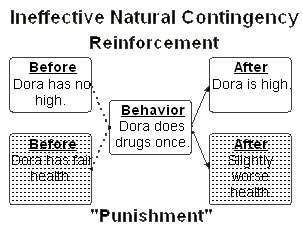
The natural “punishment” contingency does not effectively
punish doing drugs becuase the outcome is too small (the outcome of
a single response is an infinitesimally small decrement in the quality
of Dora’s health). This outcome is too small, although the cumulative
outcome of hundreds of such responses might be significantly large
and very aversive.
These preceding examples illustrate one major cause of poor self-management:
Rules often fail to control behavior, if they describe contingencies
with outcomes that are too small, though of cumulative significance.
There is one other major cause of poor self-management: Rules often
fail to control behavior, if they describe contingencies with significant
but improbable outcomes. For example, Dora continues to shoot heroine
with shared needles, even though she knows she might get AIDS from
one of them. But the probability of getting AIDS from any single instance
is too small to control her behavior.
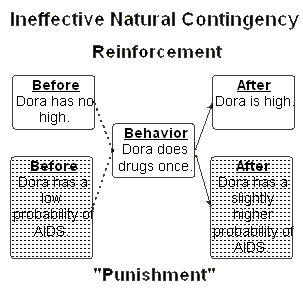
We can summarize our position as follows: Poor self-management results
from poor control by rules describing outcomes that are either too
small (though often of cumulative significance) or too improbable.
The
delay is not crucial.
Victim Blaming. We should not make the mistake of blaming the victim:
True, Dora can not get herself to find a job (she can not get her
job searching behavior under the control of the natural contingencies
so that she will succeed); but that does not mean she does not want
a job. And true, Debby can not get herself to find references (she
can not get her reference searching and her dissertation-proposal-writing
behavior under the control of the natural contingencies so that she
will succeed); but that does not mean she does not want a Ph.D. degree.
Dora and Debby care, and I hope the present analysis provides a viable
option to victim blaming, a reinforcing activity not limited to nonbehaviorists
The
Solution: Performance-Management Contingencies
Traditional,
Ineffective Performance-Management Contingencies Designed to Increase
Performance
One type of ineffective performance-management contingencies, especially
legal contingencies, often places severe consequences on failure to
perform large tasks. Or more correctly, ineffective performance-management
contingencies often require the completion of a large task to avoid
a severely aversive outcome. Because of the size of the task and the
delay of the outcome to be avoided, such contingencies are usually
indirect-acting, rule-governed analogs to avoidance contingencies.
The required task is often too large to be a reinforceable response
unit, as it usually has many gaps greater than 60 seconds. For example,
Dora needs to find a job before she gets kicked off welfare. Debby
needs to complete her dissertation before she gets kicked out of grad
school. And Dirk needed to publish a horrendous number of articles
and submit a horrendous number of grant proposals before he was kicked
out of his tenure-track position. They must do those things, but it
is unclear just when they really need to get started, just when they
need to make that first reinforceable response.
To understand why these performance-management contingencies are ineffective,
we must stay at the molecular level of the reinforceable response
unit; for example, instead of Dora’s finding a job, we should
look at Dora’s leaving her apartment to pick up a newspaper.
Now there is a deadline for leaving her apartment: Dora must leave
her apartment in time to do all of the remaining tasks that will lead
to her reliably finding a job before the two years are up; otherwise,
she will have no income. But it is not clear just when that deadline
occurs.
Can she wait a day, a week, a month, or a year before she will not
have enough time left to find a job? In other words, how long will
it take her to find a job? The crucial issue is, when should she start
worrying that, if she doesn’t get moving, she won’t have
enough time to find a job before she is off welfare and in even more
horrendous financial trouble.
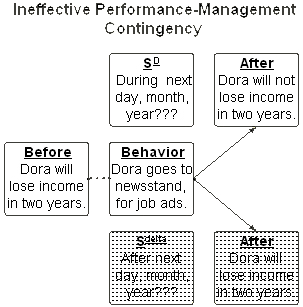
Deadlines in such analog avoidance contingencies are discriminative
stimuli, during which the contingency is in effect. Once the deadline
has past, the response will no longer avoid the aversive event.
According to the two-factor theory of avoidance, avoidance contingencies
control behavior, only if there is a supporting escape contingency
(Mower, 1947).
How does the before condition in these supporting escape contingencies
acquire it’s learned aversiveness? Through a verbal-analog to
pairing with the aversive outcome that the avoidance response would
avoid.
This is a verbal, rule-governed analog to a direct-acting pairing
procedure, because the paring would not be immediate (the two stimulus
conditions would not occur within 60 seconds of each other). And,
in fact, the pairing would not even have occurred before it was too
late. That is why it is a verbal, rule-governed analog. But analog
pairing can work quite well with verbal human beings. The delay between
the conditions being paired is not a problem.
Unfortunately, however, there is a problem; this pairing procedure
will not work; it will not establish as a learned aversive condition
the failure to go to the newsstand combed with proximity to the vague
deadline. Why? Because the deadline is too vague. There is no specific
time when it will be too late to avoid the loss of welfare. So there
is no specific time, whose proximity (combined with failure to go
to the newsstand) will be aversive. So there is no aversive before
condition that going to the newsstand will escape. So there is no
escape contingency that will support the avoidance response of going
to the newsstand. So Dora will lose her welfare support in two years.
Dora has too much leeway, too much opportunity for procrastination.
The same analysis applies to Debby’s procrastination and Duke’s
procrastination and most ineffective performance-management contingencies.
The problem with traditional, institutional performance-management
contingencies is that the responses specified in the contingencies
are too large (e.g., find a job), and thus the deadlines for the reinforceable
response units are too vague (e.g., sometime within the next two years.
These ineffective performance-management contingencies are little
better than the ineffective natural contingencies they were designed
to supplement.
Traditional,
Ineffective Performance-Management Contingencies Designed to Decrease
Performance
The other type of ineffective performance-management contingency,
especially legal contingencies, often places severe, low probability
consequences on the occurrence of undesirable behavior. For example,
if Dora is caught using illegal drugs, she is kicked off welfare.
The problem with this, as a performance-management contingency is
that the probability of her being caught and then kicked off welfare
is too low to effectively control the frequency of her drug use.
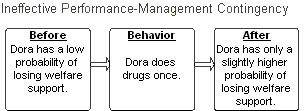
Of course, if Dora uses illegal drugs often enough, she may likely
be caught and be kicked off welfare. But the probability that she
will be caught sooner or later exerts little control over her behavior.
It is the probability that she will be caught after the next instance
of drug use that is the major determinant of her behavior. And increasing
the severity of an improbable outcome is of little value.
Effective
Performance-Management Contingencies
Essentially all performance-management contingencies with normal,
verbal adults use instrumental outcomes, rather than hedonic outcomes.
No one will put an m&m (hedonic reinforcer) in Dora’s mouth
each time she finds a job ad nor in Debby’s mouth each time
she finds a reference. And finding one job add or finding one reference
is only an instrumental reinforcer (instrumental toward getting a
job or a Ph.D.); and such instrumental reinforcers do not seem to
be very reinforcing, in and of themselves. This distinction is important
because Dora and Debby and the rest of us need deadlines to prevent
terminal procrastination if our behavior is to be effectively controlled
by rules describing contingencies with instrumental outcomes. We do
not need deadlines when our behavior is to be controlled by rules
describing hedonic outcomes.
Furthermore, the response-unit specified in the performance contracts
needs to be much smaller than the molar response unit needed to achieve
significant outcomes (e.g., finding a job or writing a dissertation).
However, the performance-contract-specified response-unit need not
be as small as a reinforceable response unit with only minimal gaps.
Debby’s
Deliverance, the Details
Bobby Behavior: “How about this for your first subgoals: Tomorrow,
you work at least two hours on your dissertation and e-mail me at
least five relevant references by 10:00 P.M.?
Debby: Uh huh.
Bobby B.: And for your general performance-management contract, every
time you fail to meet your hours or task sub-goals, you lose one point
from the total required for the week.
Debby: Uh huh.
Bobby B.: And if you accumulate two weeks bellow 90%, your grade for
your one-credit dissertation course goes down one letter grade.
Debby: Ouch.
Bobby B.: So you’re working with daily deadlines to avoid the
loss of points which can turn into the loss of a good grade at the
end of the semester. Will that work?”
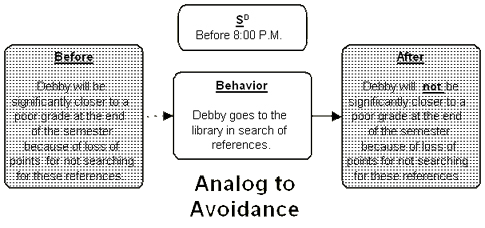
Debby: “I sure hope so; I feel like I shouldn’t be sitting
here but should be off in search of my references right now.”
Dora’s
Deliverance, the Details
Debby: “How about this for your first subgoals: Tomorrow, you
work at least two hours on your job search and call me with at least
five relevant job ads by 10:00 P.M.?
Dora: Uh huh.
Debby: And for your general performance-management contract, every
time you fail to meet your hours or task sub-goals, you lose one point
from the total required for the week.
Dora: Uh huh.
Debby: And if you accumulate two weeks bellow 90%, you will lose one
week’s welfare support.
Dora: Ouch.
Debby: So you’re working with daily deadlines to avoid the loss
of points which can turn into the loss of support the week after your
second week of failure. Will that work?”
Dora: “Oh, my. You bet it will.”
Deliverance
Analysis
Although such performance-management contingencies effectively control
the behavior of most verbal human being, they are really only indirect-acting.
rule-governed analogs to the direct-acting avoidance contingencies
of the Skinner box. In other words, the end of the semester is too
delayed for the avoidance of the poor grade to directly support the
avoidance response. Even with verbal human beings who can state the
rule describing the indirect-acting analog contingency, there must
be direct-acting contingencies that support this rule-governed behavior.
In the present case, a direct-acting escape contingency would support
the indirect-acting rule-governed analog to avoidance.

The escape and avoidance contingencies can then combine to illustrate
the two-factor theory of avoidance. The only difference is from the
traditional application of the two-factor theory is that, in the present
case, the avoidance contingency is an indirect-acting analog rather
than a direct-acting contingency, as is needed with nonverbal animals.
(With nonverbal animals, there is a direct, contiguous pairing between
the avoided aversive condition [after condition] and the escaped warning
stimulus [before condition]. For example, in classical avoidance,
the buzzer is soon followed by an electric shock. Through this pairing,
the buzzer becomes a learned aversive warning stimulus.)
However, in Debby’s case, the pairing is too delayed for the
before condition of the escape contingency to become a learned aversive
warning stimulus simply through the pairing per se with the after
condition of the avoidance contingency. Instead, a verbal statement
describes the relation between the before condition of the escape
contingency (no progress on her thesis plus proximity to the weekly
deadline) and the after condition of the avoidance contingency (a
poor grade at the end of the semester). This statement constitutes
a verbal pairing process, analogous to the direct pairing of the buzzer
and the shock in the Skinner box. And such analog paring procedures
can be effective with verbal human beings.
These components combine in accord with the two-factor theory of
avoidance.
A similar analysis applies to the effective performance management
contingency Debby set up for Dora:
Dora’s
Drug Deal Deliverance
Debby: I’ve managed to cut a special deal with the judge and
the head of our welfare agency. You get one more chance, but we’re
going to be on you like white on rice. You’ve got to produce
a clean urine sample, everyday, seven days a week. Any time you come
within a city block of heroine, your urine sample will show it. You’ve
got to stay squeaky clean. If not, you’re permanently off welfare
and also into the Women’s Detention Center.
Dora: That’s pretty rough.
Debby: Yeah, it is; but you know it’s the best deal in town.
It’s the best I could get for you. And also, you know it’s
going to keep you off heroine.
Dora: Yeah, it’ll do that alright. And I guess it’s worth
the hassle.

This effective performance-management contingency differs from the
traditional, ineffective ones only in that the probability of the
outcome is 1.0 rather than some extremely low probability. Our behavior
is much more reliably controlled by rules describing outcomes that
are small but probable than outcomes that are large but improbable,
always keeping in mind that we are talking about the probability of
the outcome for each single instance of the response and not about
the probability, that sooner or later the outcome will occur (e.g.,
losing welfare and entering detention). In Dora’s case, the
outcome is severe, because that might be the only politically acceptable
option available to a convicted felon; but from a performance-management
perspective, the outcome could have been much less severe; and yet
the rule describing the contingency would have still controlled her
behavior.
The
Three-Contingency Model of Performance Management
The three-contingency model of performance management is a radical-behavioral
approach that takes into consideration the role of verbal behavior
(language) in the analysis of contingencies controlling and failing
to control human behavior (Malott, 1993). In the preceding diagram
of the three-contingency model of performance management applied to
drug use, we not only included the ineffective natural contingency
and the effective performance-management contingency, but also the
third contingency, the direct-acting theoretical contingency. We need
the direct-acting theoretical contingency to explain why the indirect-acting
performance-management contingency works, why it controls behavior.
In Dora’s case, much more than 60 seconds would elapse between
her injection of heroine and her arrest, loss of welfare benefits,
and incarceration. This delay of hours or days means that the aversive
outcomes of arrest, etc. would be too delayed to punish her using
heroine. So a more direct-acting contingency is needed, thus the inferred
fear of the loss of welfare and freedom (i.e., the thoughts of such
a loss) which would suppress Dora’s behavior leading to the
use of heroine so that the heroine use, itself, would not occur. Traditional,
methodological behaviorists usually object to such inferences, but
such inferences seem less an evil than trying to explain the effectiveness
of the performance management contingency by treating it simplisticly,
as if it were a direct-acting punishment contingency rather than an
indirect-acting, rule-governed analog to a punishment contingency.
We can apply the complete three-contingency model of performance management
not only to contingencies designed to reduce performance (i.e., illegal
drug use) but also to contingencies designed to increase performance.
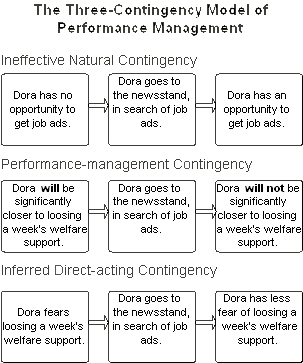
Consider the before and after conditions of Dora’s inferred
direct-acting contingency. I describe them with summary expressions
like Dora fears losing a week’s welfare support rather than
the more cumbersome expressions like Dora experiences the aversive
condition of proximity to 8:00 P.M. with no progress toward getting
her five job ads and her two hours of work.. However, it should be
understood that the before and after conditions of this contingency
are the same the before and after conditions of the earlier escape
contingency specified in the two-factor diagram. Similarly, Debby’s
inferred direct-acting contingency in the following three-contingency
diagram, is the same as in her previous two-factor diagram.
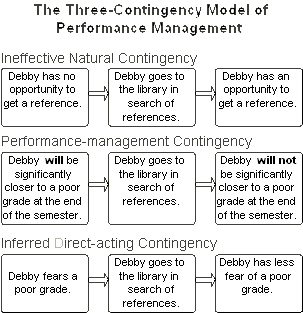
Conclusions
In conclusion, the three-contingency model of performance management
suggests contingencies that could provide an effective basis for welfare
reform. This model also suggests an analysis of the performance-management
contingencies of traditional efforts at welfare reform; and, in turn,
that analysis suggests such traditional reform will not effectively
increase functional behavior such as job finding nor decrease dysfunctional
behavior such as drug abuse.
References
Based on Baer, D. M., Peterson, R. F., & Sherman, J. A. (1967).
Development of imitation by reinforcing behavioral similarity to a
model. Journal of the Experimental Analysis of Behavior, 10, 405--415.
Malott, R. W. (1993, October). The three-contingency model applied
to performance management in higher education. Educational Technology,
33, 21-28.
Malott, R. W. & Garcia, M. E. (1991). The role of private events
in rule-governed behavior. L. J. Hayes & P. Chase (Eds.), Dialogues
on verbal behavior (pp. 237-254). Reno, NV: Context Press.
Malott, R. W. , Whaley, D. W., & Malott, M. E., (1997) Elementary
principles of behavior (third edition). Upper Saddle River, NJ: Prentice
Hall.
Mower, O. H. (1947). On the dual nature of learning—a reinterpretation
of “conditioning” and “problem solving.” Harvard
Educational Review, 17, 102-148.
Nevin, J. A. (1999) ??. Behavior Analysis and Social Issues. ??